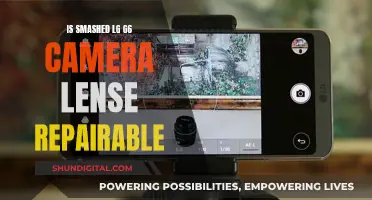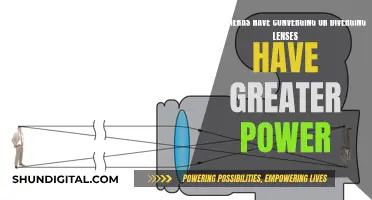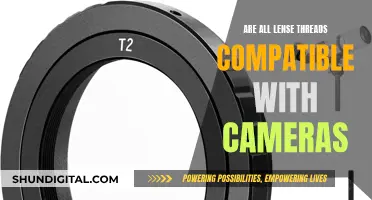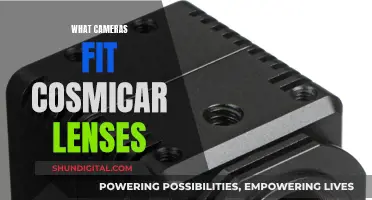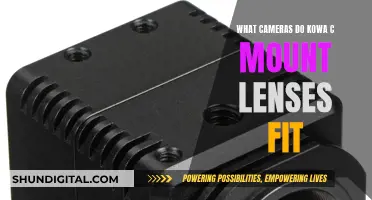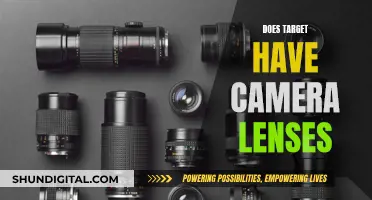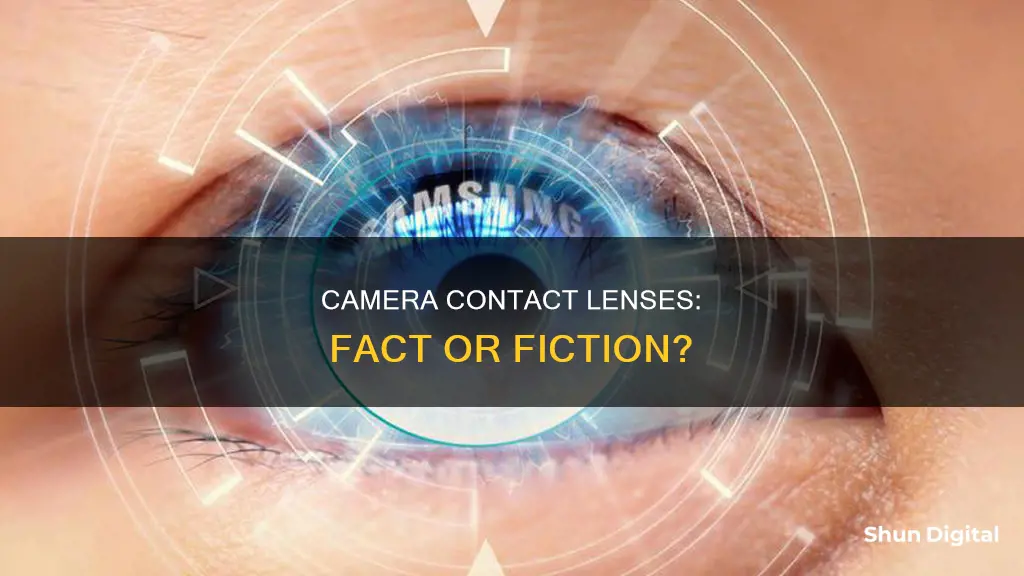
Smart contact lenses are no longer a futuristic concept. In fact, several companies are already researching and developing this technology, with some having filed patents for smart contact lenses with built-in cameras. These lenses could have a wide range of applications, from healthcare to augmented reality and photography. While the idea of a contact lens with a camera may seem like something out of a sci-fi movie, it's important to consider the potential implications for privacy and data security as this technology moves closer to becoming a reality.
What You'll Learn

Camera contact lenses that can record video
Sony has been at the forefront of this innovation, with a patent for contact lenses that can record, store, and play videos, as well as adjust zoom, focus, and aperture automatically. These lenses are designed to be controlled by the wearer's blinking, with different eyelid movements corresponding to different functions. For example, closing the eyelids can switch the camera mode on and off, while a predetermined eyelid movement can be used to play videos. The lenses can also distinguish between voluntary and involuntary blinking, ensuring that the wearer has control over the recording process.
Samsung has also joined the race with its smart contact lenses, which include a built-in camera and sensors that are controlled by blinking. However, unlike Sony's lenses, Samsung's smart lenses rely on a smartphone to process and store the recorded content.
Google is not far behind, with patents for smart contact lenses that have flexible electronics and sensors to monitor the wearer's health. While their initial focus has been on diabetes management, there is potential for further development in this area.
The implications of this technology are far-reaching. In addition to enhancing our vision and providing medical benefits, these smart contact lenses could revolutionize the way we interact with the world, raising questions about privacy and social norms. As we wait for these innovations to come to market, it is essential to consider the potential impact on our lives and the necessary safeguards to protect our data and privacy.
While the future of camera contact lenses that can record video looks promising, there are still challenges to be addressed, such as power delivery and user safety. However, with the rapid advancements in technology, it is only a matter of time before we see these innovative products on the market, offering unprecedented convenience and functionality.
How Lenses Transform Your Camera's Vision
You may want to see also

Camera contact lenses that can take photos
Contact lenses with built-in cameras may sound like something out of a sci-fi movie, but they are, in fact, a reality. Several companies, including Google, Samsung, and Sony, have been working on developing this technology, and while it may not be widely available just yet, it is certainly an exciting development with a wide range of potential applications.
These smart contact lenses are designed to be worn like regular contact lenses, without the need for any surgery. They contain tiny versions of existing technology, such as cameras, sensors, and processors, all embedded within the lens. The camera is positioned near the edge of the lens so that it doesn't obscure the wearer's vision. By following the wearer's gaze, the camera can capture images or videos of whatever the person is looking at.
Controlled by Blinking
One of the most fascinating aspects of these camera contact lenses is how they are controlled. Inventors have designed the lenses to respond to the wearer's blinking patterns. For example, a deliberate blink, which is longer in duration than an involuntary blink, can be used to activate the camera or take a photo. This allows for hands-free control of the device.
Potential Applications
The possibilities for using camera contact lenses are endless. One of the most promising applications is in healthcare, particularly for people with visual impairments. These lenses could act as a bionic eye system, providing early warnings of hazards, facial recognition, and even night vision. They could also monitor physiological parameters such as glucose levels in tears for diabetic patients or intraocular pressure for glaucoma patients.
In addition, camera contact lenses could revolutionize the way we interact with technology, offering a discreet way to view and interact with digital content without the need for bulky headsets or screens. This has implications for augmented reality (AR) and virtual reality (VR) experiences, as well as for military, security, and policing applications.
Privacy Concerns
While the potential benefits of camera contact lenses are significant, there are also valid concerns about their use, particularly around privacy. If these lenses become mainstream, how will privacy be regulated? How might law enforcement utilize this technology, and what impact could it have on social norms if people are worried about being recorded at all times? These are important questions that will need to be addressed as this technology moves towards widespread adoption.
Best Places to Sell Your Camera Lenses Online
You may want to see also

Camera contact lenses that can be controlled by blinking
Smart contact lenses with built-in cameras are currently being developed by tech giants such as Google and Samsung. These lenses can be controlled by blinking and are set to revolutionize the way we interact with technology, offering a more immersive and discreet experience.
The smart contact lenses work by detecting eye movements and blinking patterns. The lenses can differentiate between involuntary and intentional blinking, allowing users to take photos or zoom in and out by winking or double blinking. The built-in camera follows the wearer's gaze, providing a wide range of applications.
Potential Applications
These smart contact lenses have numerous potential applications. They can be used as a bionic eye system for the visually impaired, providing early warnings of hazards and offering facial recognition capabilities. They can also enhance human abilities with features such as telescopic vision, infrared/night vision, and the ability to digitally zoom in. In a military context, these lenses could alert soldiers to incoming fire, provide infrared vision in smoky conditions, and aid in accurate sniping.
Health Monitoring
In addition to their imaging capabilities, these smart contact lenses can also monitor various health parameters. For example, they can track the progress of glaucoma, measure glucose levels in tears to assist diabetics, and release allergy-relief medication. By continuously collecting and recording biometric data, these lenses could be integrated into care plans for patients with chronic diseases, providing non-invasive health monitoring.
Augmented Reality
Smart contact lenses are also being explored as the next frontier in augmented reality (AR) and virtual reality (VR). Tech companies are developing lenses that can project virtual objects or videos directly onto the wearer's eye, controlled via a smartphone. This technology could provide a seamless and immersive AR experience without the bulkiness of traditional headsets, potentially pushing AR and VR into the mainstream.
Privacy and Ethical Considerations
While these smart contact lenses offer exciting possibilities, they also raise important privacy and ethical concerns. The presence of recording devices in people's eyes could lead to worries about constant surveillance and potential misuse of data. As this technology moves towards widespread adoption, new legislation and regulations will be necessary to address these complex issues and protect individuals' privacy and security.
Analog Camera Lenses: Interchangeable or Not?
You may want to see also

Camera contact lenses that can be used for facial recognition
Google's smart contact lens would have a tiny CMOS camera sensor, a control circuit, and a method of receiving power wirelessly. The imaging sensor would likely be colour-matched to the wearer's iris to maintain a natural appearance. While the lens itself would not be transparent due to the nature of imaging sensors, it would not look "too freaky".
The camera could stream its feed to a nearby smartphone or head-mounted display, where a more powerful computer could perform real-time processing. This could include facial recognition, as well as infrared thermal night vision and the ability to digitally zoom in.
While Google's smart contact lens is still in the early stages of development, the technology to create such devices is very close to becoming a reality.
Anti-Camera Lenses: Worth the Investment?
You may want to see also

Camera contact lenses that can be used for augmented reality
Camera Contact Lenses for Augmented Reality: Science Fiction to Reality
Contact lenses with built-in cameras may sound like something out of a sci-fi movie, but they are rapidly becoming a reality. Several companies are developing smart contact lenses that can record video, take pictures, and even project virtual objects directly onto the wearer's eye, offering exciting possibilities for augmented reality (AR) experiences.
Google's Smart Contact Lens
Google has developed a smart contact lens with an integrated camera. The camera would be positioned near the edge of the lens so as not to obscure the wearer's vision. By following the wearer's gaze, the lens could have a range of applications, including facial recognition, infrared/night vision, and early warning systems.
Sony's Camera Contact Lens
Sony has proposed a contact lens with a camera, on-board memory, a camera controller, wireless data transmission, and wireless power. The lens would be controlled by the wearer's blinking, distinguishing between natural and deliberate blinks by measuring the duration of the blink.
Mojo Vision's Smart Contact Lens
Mojo Vision has developed a smart contact lens with a MicroLED display, an ARM processor, a 5GHz radio, and medical-grade micro-batteries. The lens can project a graphical user interface with text and images, and the company is working on eye-tracking capabilities to enable interaction with the device.
UCSD's Zoom Contact Lens
Scientists at the University of Southern California San Diego have created a biomimetic soft zoom contact lens that changes focal length when triggered by tiny electrical signals caused by blinking. While the current technology is too large to wear in the eye, further refinement could lead to its use in visual prostheses and adjustable glasses.
The Future of AR
AR contact lenses pose significant engineering challenges, particularly in terms of power and wireless communication. However, companies like Mojo Vision have made impressive strides in these areas, bringing us a step closer to a world where AR contact lenses are commonplace. As the technology advances, we can expect to see these lenses used in a variety of fields, from entertainment to healthcare, revolutionizing the way we interact with digital content.
Lens and Camera Compatibility: Universal Fit or Not?
You may want to see also
Frequently asked questions
Yes, camera contact lenses are real. Several companies have patented smart contact lenses with built-in cameras that can record video and take pictures.
Camera contact lenses use tiny cameras and sensors to capture images and videos. The lenses can be controlled through blinking or via a smartphone.
Camera contact lenses have a range of potential applications, including medical monitoring for conditions like diabetes, enhancing vision for the visually impaired, and providing early warning systems.
Yes, there are concerns about privacy and data security. The widespread use of camera contact lenses may also impact social norms and interactions.
Companies such as Google, Sony, and Samsung have all patented or developed camera contact lens technologies. Other companies like Verily and the University of Michigan are also researching smart contact lenses for medical and military applications.


